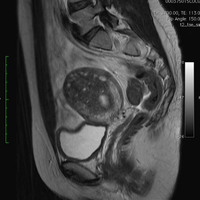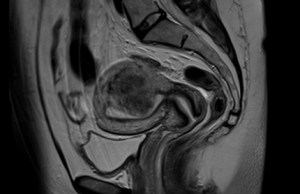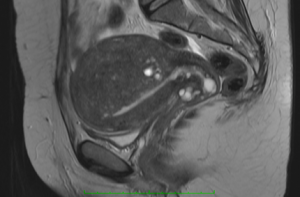Adenomyosis is a condition related to endometriosis in which pockets of endometrium-like material are embedded within the myometrium or muscle of the uterus. It can either be diffuse or localised (focal). It causes painful enlargement and swelling of the uterus. The focal lesions are also called adenomyomas and are often misdiagnosed as fibroids – which are much more common. It is important to make the diagnosis as adenomyosis can be very difficult to remove surgically because, unlike fibroids, there is no clear plane of cleavage to allow them to be shelled out. Like fibroids, adenomyosis can affect implantation causing miscarriage and delay in conceiving.
Diagnosis is made by ultrasound scan or MRI
ADENOMYOSIS SEEN AT MRI

Treatment
Excisional surgery is not recommended as the risks of excessive bleeding, loss of endometrium leading to Asherman’s Syndrome and hysterectomy are quite high. Symptomatic relief can be obtained using the Mirena IUS or oral progestagens. Larger lesions which are thought to be interfering with fertility can be shrunk using a GnRH analogue such as zoladex or prostap prior to trying to conceive. Trials are underway using a selective progesterone receptor modulator (SPRM) called ullipristal acetate which may also be helpful.
For women whose family is complete who have disabling symptoms of painful and heavy periods the best option is a hysterectomy. Laparoscopic subtotal hysterectomy is a minimally invasive treatment well suited to adenomyosis.
The images below show the subtle differences between a fibroid (in the top picture) and focal adenomyosis (in the bottom picture).

